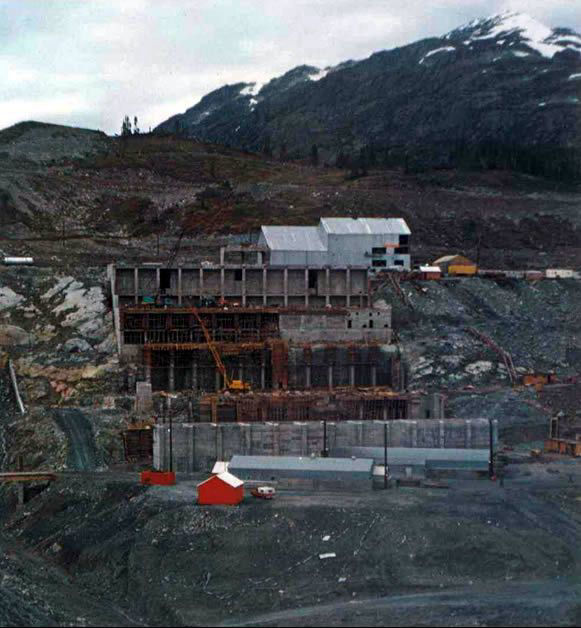Granduc Mine

Geology - Continued
Photo - Granduc Concentrator being built
The deposit lies in a northwestern-trending belt of Mesozoic volcanic rock, assigned to the Hazelton Group, close to the east side of the "Coast Range Batholith" of granitic rocks. The sedimentary rocks in which this deposit occurs are unfossiliferous at Granduc Mountain, but can be traced north into beds at Unuk River containing fossils of Upper Triassic age (Karenina). These are overlain by argillite, andesite, greywacke and a conglomerate with granitic boulders. The conglomerate is part of sedimentary beds containing early Jurassic (Hettangian) fossils. The Coast Range intrusive may include, therefore, members of Triassic or earlier age.
To build the Granduc concentrator required six step-like set-backs in the rocky cliff to form the foundation for the ore treatment plant, shown here under constructionThe intrusive rocks at Granduc belong to three main groups whose relative ages are not certainly established. The oldest group is apparently confined to an area of Triassic rocks and consists of crosscutting stocks and irregular bodies ranging from diorite to granodiorite. The granodiorite of the oldest group is well foliated, suggesting introduction during deformation, but the diorites are unfoliated and in part are intensely sheared and converted to chloritic schist. Andesite and andesite porphyry dikes occur in the mine. These predate the ore and have been strongly sheared and folded. They may be assigned to the oldest of the three igneous suites (Triassic?) or to a cupriferous syenite group (post-early Jurassic) that occur directly north of the mine area.
The other two groups of intrusive rocks are infoliated. One group occurs as a northwesterly dike swarm, which crosscuts the Granduc ore zone and consists of diorite and quartz diorite with chilled margins of andesite. These dikes are offset a few hundred feet by the latest movements on the Granduc and other parallel faults. Although clearly faulted by the late fault movements, they do send out sill-like extensions within or marginal to the Granduc fault zone suggesting that the early fault movements predate the dike swarm injection.
The Coast granodiorite masses, which are the other unfoliated group at Granduc, have not been seen to contact the dike swarm. The general evidence Granduc fault, but were emplaced either after or very late in the series of events that produced the complex fold-fault patterns at Granduc. A large specimen with biotite alteration, associated with GEOLOGY the ore, was taken by Dr. E. D. Kindle of the Canadian Geological Survey, and may provide data on the age of the ore. This might supply information on the suggests that these masses are also relative age of the Coast Range granitic faulted by the late movements on the rocks and the Granduc structures.
NEXT ENGINEERING